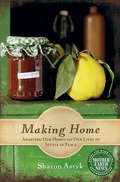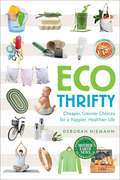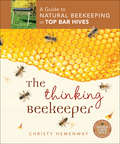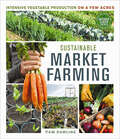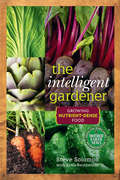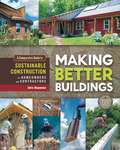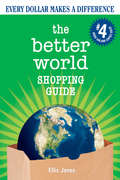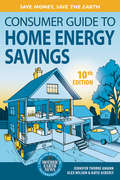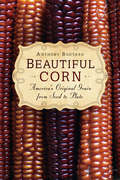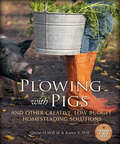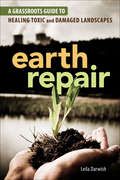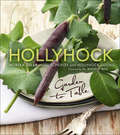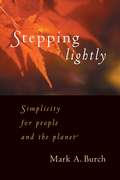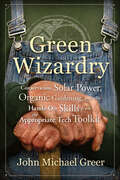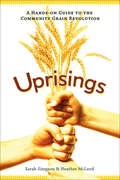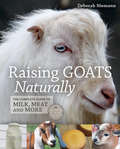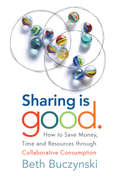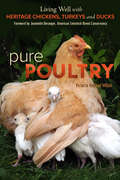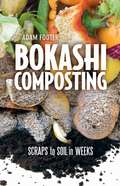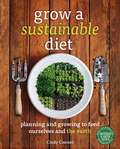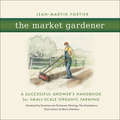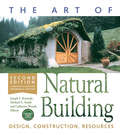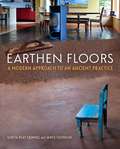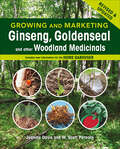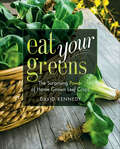- Table View
- List View
Making Home: Adapting Our Homes and Our Lives to Settle in Place (Mother Earth News Books for Wiser Living)
by Sharon Astyk&“Shows us why the actions that prepare us for emergencies and energy descent are the right things to do no matter what the future brings.&” —Toby Hemenway, author of Gaia&’s Garden Other books tell us how to live the good life—but you might have to win the lottery to do it. Making Home is about improving life with the real people around us and the resources we already have. While encouraging us to be more resilient in the face of hard times, author Sharon Astyk also points out the beauty, grace, and elegance that result, because getting the most out of everything we use is a way of transforming our lives into something much more fulfilling. Written from the perspective of a family who has already made this transition, Making Home shows readers how to turn the challenge of living with less into settling for more—more happiness, more security, and more peace of mind. Learn simple but effective strategies to: · Save money on everything from heating and cooling to refrigeration, laundry, water, sanitation, cooking, and cleaning · Create a stronger, more resilient family · Preserve more for future generations We must make fundamental changes to our way of life in the face of ongoing economic crisis and energy depletion. Making Home takes the fear out of this prospect, and invites us to embrace a simpler, more abundant reality. &“Americans are born to be transient—Sharon Astyk has the prescription for dealing with that genetic disease, and building a healthy nativeness into our lives.&” —Bill McKibben, New York Times–bestselling author &“Exhaustively researched and compassionately delivered.&” —Harriet Fasenfest, author of A Householder&’s Guide to the Universe
Ecothrifty: Cheaper, Greener Choices for a Happier, Healthier Life (Mother Earth News Books for Wiser Living)
by Deborah NiemannA guide to saving a fortune while saving the Earth, from the author of Homegrown & Handmade. Use it up, wear it out, make it do, or do without. Our grandmothers knew the importance of responsible, thrifty choices. But somewhere along the way we lost our way and succumbed to the belief that we can get everything for next to nothing, have it shipped halfway around the world and then—more often than not—just throw it away. This consumer binge is taking its toll. Diet and lifestyle-related illnesses are epidemic, our environment is awash in a sea of plastic, our climate is changing, and the cost of everything is skyrocketing with the price of oil. Are we doomed? No. We can make greener, healthier choices, and we can do it while saving money. Where to start? Ecothrifty is packed with simple, practical ideas and recipes to help you:· Make homemade products for cleaning and skin care · Grow your own food and cook more from scratch · Raise your family without lowering your standards A must-read for anyone who has ever wanted to live a greener life but thought that it would be too expensive, time-consuming, or difficult, this handy, complete guide will show you how small changes can have a huge environmental impact and save you thousands of dollars, all while improving your quality of life.&“I support and endorse this wonderful book, 100%!&” —Ed Begley, Jr., actor and environmentalist&“Her advice does not come across as self-righteous or preachy, but more like insider tips from an experienced do-it-yourselfer.&” —Publishers Weekly
The Thinking Beekeeper: A Guide to Natural Beekeeping in Top Bar Hives (Mother Earth News Books for Wiser Living)
by Christy HemenwayA beginner&’s complete guide to keeping bees in top bar hives, and why. What&’s the buzz about the growing popularity of backyard beekeeping? Providing habitat for bees, pollinating your garden, and producing honey for your family are some of the compelling reasons for taking up this exciting hobby. But conventional beekeeping requires a significant investment and has a steep learning curve. The alternative? Consider beekeeping outside the box.The Thinking Beekeeper is the definitive do-it-yourself guide to natural beekeeping in top bar hives. Based on the concept of understanding and working with bees&’ natural systems as opposed to trying to subvert them, the advantages of this approach include:· Simplicity, sustainability, and cost-effectiveness · Increased safety due to less heavy lifting and hive manipulation · Chemical-free colonies and healthy hives Top bar hives can be located anywhere bees have access to forage, and they make ideal urban hives. Emphasizing the intimate connection between our food systems, bees, and the well-being of the planet, The Thinking Beekeeper will appeal to the new breed of beekeeper who is less focused on maximizing honey yield, and more on ensuring the viability of the bee population now and in the coming years.Mother Earth News Books for Wiser Living Recommendation&“You&’ll find information you need here that&’s not available anywhere else. Both you and your bees will benefit from Christy&’s approach, advice, and philosophy.&” —Kim Flottum, editor, Bee Culture Magazine&“A unique and exceptional resource for the beginning beekeeper.&” —Marty Hardison, top bar beekeeper, educator and international developmental beekeeping consultant
Sustainable Market Farming: Intensive Vegetable Production on a Few Acres (Mother Earth News Books for Wiser Living)
by Pam DawlingGrowing for 100 - the complete year-round guide for the small-scale market grower. Across North America, an agricultural renaissance is unfolding. A growing number of market gardeners are emerging to feed our appetite for organic, regional produce. But most of the available resources on food production are aimed at the backyard or hobby gardener who wants to supplement their family's diet with a few homegrown fruits and vegetables. Targeted at serious growers in every climate zone, Sustainable Market Farming is a comprehensive manual for small-scale farmers raising organic crops sustainably on a few acres.Informed by the author's extensive experience growing a wide variety of fresh, organic vegetables and fruit to feed the approximately one hundred members of Twin Oaks Community in central Virginia, this practical guide provides:Detailed profiles of a full range of crops, addressing sowing, cultivation, rotation, succession, common pests and diseases, and harvest and storageInformation about new, efficient techniques, season extension, and disease resistant varietiesFarm-specific business skills to help ensure a successful, profitable enterpriseWhether you are a beginning market grower or an established enterprise seeking to improve your skills, Sustainable Market Farming is an invaluable resource and a timely book for the maturing local agriculture movement.
The Intelligent Gardener: Growing Nutrient-Dense Food (Mother Earth News Books for Wiser Living)
by Steve Solomon Erica Reinheimer&“It is bold, it is courageous, and it challenges many of our preconceptions about food, about soils, about farming, and about health.&” —Michael Ableman, farmer, author of Farm the City To grow produce of the highest nutritional quality, the essential minerals lacking in our soil from intensive agriculture must be replaced. The Intelligent Gardener is the practical, step-by-step guide for any serious gardener who wants to: · Demystify this process · Debunk much of the false and misleading information perpetuated by both the conventional and organic agricultural movements · Re-mineralize our soil. Accompanied with customizable web-based spreadsheets, this toolkit calls for far more attention to detail than the simple addition of composted manure or NPK fertilizers. It conclusively establishes the link between healthy soil, healthy food, and healthy people. Vegetables, fruits, and grains are a major source of vital nutrients, but centuries of intensive agriculture have depleted our soils to historic lows. As a result, the broccoli you consume today may have less than half the vitamins and minerals that the equivalent serving would have contained a hundred years ago. This is a matter of serious concern, since poor nutrition has been linked to myriad health problems including cancer, heart disease, obesity, high blood pressure, and diabetes. For optimum health we must increase the nutrient density of our foods to the levels enjoyed by previous generations. The Intelligent Gardener goes beyond organic—it offers the essential tools for those who care about the quality of the produce they grow. &“It&’s hard to imagine this book not having a significant and lasting impact on the way organic farmers and gardeners grow their crops.&” —Mark McDonald, West Coast Seeds
Making Better Buildings
by Chris Magwood Jen FeiginMuch has been written about the individual components of sustainable building, but how do you bring it all together into a well-designed whole? Drawing on extensive hands-on experience, Making Better Buildings systematically describes the real-world implications of the most popular green and natural building materials and techniques, objectively presenting the pros, cons and overall viability of each. An indispensable resource.
The Better World Shopping Guide
by Ellis JonesAccording to the latest research, the average American family spends nearly $22,000 a year on goods and services--that's 22,000 votes for the world you want to live in. Do you want to ensure your money is supporting companies who work to make the world a better place, or risk its going to corporations who make their decisions based solely on the bottom line? The Better World Shopping Guide is the only comprehensive guide for socially and environmentally responsible consumers. This perennial bestseller rates every product on the shelf from A to F so you can quickly tell the "good guys" from the "bad guys"--turning your shopping list into a powerful tool to change the world. Drawing on decades of meticulous research, this completely revised and updated fourth edition will help you find out which companies actually "walk the talk" when it comes to: Environmental sustainability Human rights Community involvement Animal protection Social justice Small enough to fit in a back pocket or handbag and organized in a user-friendly format, The Better World Shopping Guide will help you change the world as you shop. Ellis Jones, PhD, is the award-winning, best-selling author of The Better World Shopping Guide and The Better World Handbook. A scholar of social responsibility, global citizenship, and ethical consumerism, Jones has dedicated himself to uncovering practical ways for people to make a difference in the world. He currently teaches in the Department of Sociology at Holy Cross College.<P><P> Advisory: Bookshare has learned that this book offers only partial accessibility. We have kept it in the collection because it is useful for some of our members. To explore further access options with us, please contact us through the Book Quality link on the right sidebar. Benetech is actively working on projects to improve accessibility issues such as these.
Consumer Guide to Home Energy Savings
by Alex Wilson Jennifer Thorne Amann Katie AckerlyIncreasing the energy efficiency of your home can save you money, help the environment, and enhance your comfort, but how do you decide which improvements are the most beneficial and cost-effective? Completely revised to incorporate the latest developments in green technology, The Consumer Guide to Home Energy Savings is the definitive resource for consumers who want to better their home's performance while reducing their energy bills. Well-organized and highly readable, The Consumer Guide to Home Energy Savings begins with an overview of the relationships between energy use, economics, and the environment. Updated and expanded chapters focus on specific aspects of any home, such as heating and cooling, ventilation, electronics, lighting, cooking, and laundry, and provide helpful explanations for each, including: Energy use characteristics Comparisons between available technologies Cost-effective repair and replacement options Step-by-step guidance for finding the right equipment This comprehensive resource is packed with tips on improving existing equipment and guidance for when and why to invest in new purchases, as well as a reminder to check local government and utilities for purchase or retrofit grants or incentives. It is a must-read for anyone concerned about reducing both their energy bills and their environmental impact. Jennifer Thorne Amann is the buildings program director at the American Council for an Energy-Efficient Economy (ACEEE). Alex Wilson is the founder of BuildingGreen, Inc, executive editor of Environmental Building News, and author of Green Building Products and Your Green Home Katie Ackerly is a researcher at the Center for the Built Environment and a graduate student in architecture ate the University of California, Berkeley.
Beautiful Corn: America's Original Grain from Seed to Plate
by Anthony BoutardCultivated from sea level to mountaintop, from parched deserts to sodden rain forests, from the rocky Gaspé Peninsula to the plains of Argentina, corn is the grain of the Americas. In terms of culinary uses, it is amazingly diverse, reflecting the breathtaking variety of the continents and environments from which it evolved. The consummate immigrant, corn is grown extensively on every continent except Antarctica. Market farmer and naturalist Anthony Boutard weaves together this unique plant's contribution to our culture, its distinctive biology, and the practical information needed to grow and enjoy it at home. Beautiful Corn advocates a return to the nourishing whole grain that built America, in place of today's genetically modified crops processed by industrial agriculture into synthetic sweeteners and cheap meat. Come along on this lyrical and inspiring journey through the seasons, learning about growing and using corn in the traditional way. Gardeners and market farmers can lead the way to a healthier country by restoring heritage corn varieties to our tables. An unabashed celebration of a much-maligned culinary treasure, Beautiful Corn will forever change the way you view this remarkable plant. Anthony Boutard is a widely recognized advocate in the local food movement, well-known for his efforts in reviving long-lost crops and bringing little-known varieties to market. He and his wife Carol own Ayers Creek Farm, a 144-acre organic market farm in Gaston, Oregon, specializing in berries, beans, grains, and greens for sale to local restaurants and markets.
Plowing with Pigs and Other Creative, Low-Budget Homesteading Solutions
by Karen K. Will Oscar H. WillFueled by a failing economy and a passionate desire for a return to simpler times, a new wave of homesteaders is seeking the good life and the kind of true satisfaction that can only be built, not bought. Many of these modern pioneers are cash poor, but rich in energy and creativity. Plowing with Pigs and Other Creative, Low-Budget Homesteading Solutions offers them a set of fresh ideas for achieving independence through sweat equity and the use of unconventional resources. This highly readable and entertaining guide brings together answers to common problems faced by homesteaders young and old, urban, suburban, and rural. Traditional knowledge is combined with MacGyver-style ingenuity to create projects that maximize available resources, including: Animal management strategies for the yard, garden, and field Pole building and construction techniques from woodlot materials Replacing farm machinery with homemade hand tools and implements Leveraging increased self-sufficiency into a home-based business Whether you are a dreamer or a doer, Plowing with Pigs will inspire, challenge, and enable you to do more with less (and have fun doing it). Oscar H. (Hank) Will III is a farmer, scientist, and author, known for seeking and implementing creative farmstead solutions. The editor of Grit magazine, Hank has published hundreds of articles and five books on a range of topics including antique farm machinery. Karen K. Will is editor of The Heirloom Gardener magazine and author of Cooking with Heirlooms: Seasonal Recipes with Heritage-Variety Vegetables and Fruits. She operates Prairie Turnip Farm with her husband Oscar H. Will III.
Earth Repair: A Grassroots Guide to Healing Toxic and Damaged Landscapes
by Leila DarwishMillions of acres of land have been contaminated by pesticides, improperly handled chemicals, dirty energy projects, toxic waste, and other pollutants in the United States alone. This toxic legacy impacts the environment, our health, our watersheds, and land that could otherwise be used to grow healthy local food and medicines. Conventional clean-up techniques employed by government and industry are tremendously expensive and resource-intensive and can cause further damage. More and more communities find themselves increasingly unable to rely on those companies and governments who created the problems to step in and provide solutions.Earth Repair describes a host of powerful grassroots bioremediation techniques, including:Microbial remediation-using microorganisms to break down and bind contaminantsPhytoremediation-using plants to extract, bind, and transform toxinsMycoremediation-using fungi to clean up contaminated soil and waterPacked with valuable, firsthand information from visionaries in the field, Earth Repair empowers communities and individuals to take action and heal contaminated and damaged land. Encompassing everything from remediating and regenerating abandoned city lots for urban farmers and gardeners to recovering from environmental disasters and industrial catastrophes such as oil spills and nuclear fallout, this fertile toolbox is essential reading for anyone who wishes to transform environmental despair into constructive action.Leila Darwish is a community organizer, urban gardener, and permaculture designer with a focus on using grassroots bioremediation to address environmental justice issues in communities struggling with toxic contamination of their land and drinking water.
Hollyhock: Garden to Table
by Andrew Weil Moreka Jolar Heidi ScheifleyHollyhock-renowned the world over as an unparalleled center of learning and connection-exists to inspire, nourish, and support people who are making the world better. At the heart of this unique institution, located on beautiful Cortes Island, is Hollyhock's spectacular organic garden, just steps from the ocean view kitchen. Serving up exquisite meals for thirty years, the Hollyhock cooks are back with a new collection, boasting over two hundred new garden-inspired recipes.Hollyhock: Garden to Table invites you to join in a celebration of the beauty of fresh, local food-filled with imaginative ideas and seasoned with global inspiration. The versatility of whole grains, healthy oils, and natural sweeteners is showcased in mouthwatering creations such as:Thin-Crust Pizza with Nettle Pesto and Roasted Sweet Potatoes, Asparagus, and ChevreBlack Sesame Crusted Albacore Tuna with Ponzu SauceSoft Polenta with Roasted Butternut Squash, Caramelized Onions, Peas, and Smoked CheddarHoney Roasted Pears with Balsamic and MascarponeFocusing on sustainable seafood and garden-fresh foods from wherever you are, Hollyhock: Garden to Table will have you leafing through its pages for your next great meal again and again. Welcome to the Hollyhock kitchen!Moreka Jolar has been a chef at Hollyhock for fifteen years. She is co-author of the best-selling cookbook Hollyhock Cooks.Heidi Scheifley is a certified gourmet natural foods chef who has cooked in kitchens from Hollyhock on Cortes Island, Canada to Greece to Southeast Asia, Egypt, Israel, Nepal, India, and Hawaii.
Stepping Lightly
by Mark A. BurchWhile the voluntary simplicity movement has grown by leaps and bounds in recent years, it is still often stereotyped as being mainly concerned with a thrifty lifestyle. But simple living has much deeper implications than just cleaning closets or selling off a second car. In Stepping Lightly, Mark Burch considers the deeper rewards of voluntary simplicity for individuals, and how the practice of simple living can be an essential part of the solution to our social and environmental problems. Thoughtful and eloquent, this book will appeal to a wide range of readers interested in committing themselves to stepping lightly into a more sustainable future.
Green Wizardry: Conservation, Solar Power, Organic Gardening, and Other Hands-On Skills from the Appropriate Tech Toolkit
by John Michael GreerTested skills for thriving in the age of limitsMerlin, Gandalf, Voldemort-these well-known sorcerers from popular culture are famed for their amazing spells and spectacular magical powers. In ancient times however, a wizard was actually a freelance intellectual whose main stock in trade was good advice, supported by a thorough education in agriculture, navigation, political and military science, languages, commerce, mathematics, medicine, and the natural sciences-in essence, the true Renaissance man.Greer proposes a modern mage for uncertain times; one who possesses a startling array of practical skills gleaned from the appropriate tech and organic gardening movements forged in the energy crisis of the 1970s. From the basic concepts of ecology to a plethora of practical techniques such as composting, green manure, low-tech food preservation and storage, small-scale chicken and rabbit raising, solar water heating, alternative energy sources, and more; Green Wizardry is a comprehensive manual for today's wizard-in-training.Providing a solid practical introduction to the entire appropriate tech toolkit, this book is a must-read for anyone concerned about decreasing our dependence on an overloaded industrial system and, in a world of serious energy shortages and economic troubles, making life a great deal less traumatic and more livable.
Uprisings: A Hands-On Guide to the Community Grain Revolution
by Sarah Simpson Heather McLeodThis practical guide explores the food security and community sufficiency benefits of growing local grain—and shows you how easy it is to get started.If we want to reduce our environmental impact, build resiliency in our community, and improve food security, it's up to us to make it happen. Uprisings shows how communities across North America can take action by reviving local grain production.Environmental journalist Sarah Simpson profiles of ten unique community models demonstrating how local grain production is already making a difference. She then shares step-by-step instructions for small-scale grain production that will turn any community into a hotbed of revolution. Learn about:How locally grown wheat, barley, and other grains can impact a communityHow to start a community grain project from scratchHow to plant, grow, harvest, thresh, winnow, and store your grainHow to use whole and sprouted grains in your kitchen
Raising Goats Naturally
by Deborah NiemannThere is no one-size-fits-all approach to raising goats (or any livestock for that matter). But by working with nature, you can raise happy, healthy dairy goats and produce your own milk, cheese, meat, fertilizer, leather, fiber and soap -- all without relying on drugs or following the factory-farm model. Raising Goats Naturally will show you how.
Sharing is Good
by Beth BuczynskiCollaborative consumption is a new way of living in which access is valued above ownership, experience is prized over material possessions, and "mine" becomes "ours," allowing everyone's needs to be met with minimum waste. Bursting at the seams with hundreds of helpful tips and valuable resources, Sharing is Good is a practical guide to this new and exciting "sharing economy."
Pure Poultry
by Victoria Redhed MillerPure Poultry is a timely resource for new and experienced poultry keepers who want to raise heritage breeds as an integral part of a more sustainable food system. This inspiring "how-to and why-to" guide combines revealing and often humorous anecdotes with detailed information on everything from housing, breeding and day-to-day care, to cooking and food preservation.
Bokashi Composting
by Adam FooterBokashi composting relies on anaerobic fermentation in a closed system to recycle food waste in your kitchen, garage or apartment. Unlike conventional composting, the bokashi method can break down heavier items like meat, fish and cheese, and usually takes no more than two weeks. From scraps to soil, Bokashi Composting is a complete, step-by-step, do-it-yourself guide to this amazing process.
Grow a Sustainable Diet
by Cindy ConnerEveryone loves to prepare a meal with ingredients fresh from their own garden. But for most of us, no matter how plentiful our harvest, homegrown produce comprises only a fraction of what we eat. And while many gardening guides will tell you everything you ever wanted to know about individual crops, few tackle the more involved task of helping you maximize the percentage of your diet you grow yourself.Grow a Sustainable Diet will help you develop a comprehensive, customized garden plan to produce the maximum number of calories and nutrients from any available space. Avoid arriving in August buried under a mountain of kale or zucchini (and not much else) by making thoughtful choices at the planning stage, focusing on dietary staples and key nutrients. Learn how to calculate: Which food and cover crops are best for your specific requirements How many seeds and plants of each variety you should sow What and when to plant, harvest, and replant for maximum yieldFocusing on permaculture principles, bio-intensive gardening methods, getting food to the table with minimum fossil fuel input, and growing crops that sustain both you and your soil, this complete guide is a must-read for anyone working towards food self-sufficiency for themselves or their family.Cindy Conner is a permaculture educator, founder of Homeplace Earth, and the producer of two popular instructional DVDs on sustainable gardening. Her passion is exploring growing a complete diet in a small space while minimizing the use of fossil fuels.
The Market Gardener: A Successful Grower's Handbook for Small-Scale Organic Farming
by Jean-Martin Fortier&“Few books have grabbed my attention as dramatically as this one—because it&’s ultimately do-able for thousands of would-be food and farm healers.&” —Joel Salatin, Polyface Farm Grow better not bigger with proven low-tech, human-scale, biointensive farming methods Making a living wage farming without big capital outlay or acreages may be closer than you think. Growing on just 1.5 acres, Jean-Martin and Maude-Helene feed more than 200 families through their thriving CSA and seasonal market stands. The secret of their success is the low-tech, high-yield production methods they&’ve developed by focusing on growing better rather than growing bigger, making their operation more lucrative and viable in the process. The Market Gardener is a compendium of proven horticultural techniques and innovative growing methods. This complete guide is packed with practical information on: · Setting-up a micro-farm by designing biologically intensive cropping systems, all with negligible capital outlay · Farming without a tractor and minimizing fossil fuel inputs through the use of the best hand tools, appropriate machinery and minimum tillage practices · Growing mixed vegetables systematically with attention to weed and pest management, crop yields, harvest periods and pricing approaches. Inspired by the French intensive tradition of maraichage and by iconic American vegetable grower Eliot Coleman, author and farmer Jean-Martin shows by example how to start a market garden and make it both very productive and profitable. &“Very well done and should be of great use to market growers everywhere.&” —Eliot Coleman, organic farming pioneer and author of The New Organic Grower &“Both visionary and practical, it is a work of rare intelligence.&” —Charles Herve-Gruyer, permaculture teacher and grower at la Fermedu BecHellouin, France
The Art of Natural Building
by Michael Smith Joseph F. Kennedy Catherine WanekThe popularity of natural building has grown by leaps and bounds, spurred by a grassroots desire for housing that is healthy, affordable, and environmentally responsible. While there are many books available on specific methods such as straw-bale construction, cob, or timber framing, there are few resources which introduce the reader to the entire scope of this burgeoning field.Fully revised and updated, The Art of Natural Building is the complete and user-friendly introduction to natural building for everyone from the do-it-yourselfer to architects and designers. This collection of articles from over fifty leaders in the field is now stunningly illustrated with over two-hundred full-color photographs of natural buildings from around the world. Learn about: The case for building with natural materials, from the perspectives of sustainability, lifestyle, and health What you need to know to plan and design your own beautiful and efficient natural home Explanations of thirty versatile materials and techniques, with resources on where to go for further information on each How these techniques are being used to address housing crises around the world. Clearly written, logically organized, and beautifully illustrated, The Art of Natural Building is the encyclopedia of natural building.Joseph F. Kennedy is a designer, builder, writer, artist, educator, and co-founder of Builders Without Borders.Michael G. Smith is a respected workshop instructor, consultant, and co-author of the best-selling book The Hand-Sculpted House.Catherine Wanek is a co-founder of Builders Without Borders and author/photographer of The Hybrid House and The New Straw Bale Home.
Earthen Floors
by James Thomson Sukita Reay CrimmelFor most of human history, people have lived in durable, comfortable buildings made from natural materials such as soil, sand, rocks, and fiber. All over the globe, these ancient traditions persist; a quarter to a third of the world's population today lives in houses built partially or entirely of earth. Conventional Western building techniques using industrial materials may save time and create efficiencies, but these perceived savings come at considerable financial and environmental cost.As well as boasting a unique and beautiful aesthetic, natural building techniques are accessible, affordable, and non-toxic. Earthen Floors: A Modern Approach to an Ancient Practice is the first comprehensive, fully illustrated manual covering the history, use, and maintenance of this attractive, practical flooring option. This detailed, fully illustrated guide explains every part of the process, including: Sourcing and harvesting materials Preparing the subfloor Pouring, finishing, and sealing the floor Living with and maintaining your earthen floorBecause information on creating quality earthen floors was not previously widely available, there have been some negative experiences. Drawing on the combined knowledge of the most qualified earthen floor practitioners, as well their own substantial experience, the authors deliver the definitive resource for this exciting technique, perfect for everyone from the novice to veteran builder.Sukita Reay Crimmel has installed over twenty thousand square feet of earthen flooring, and is one of the preeminent experts in the emerging field of earthen floors.James Thomson is part of House Alive, one of the leading natural building training organizations in the country.
Growing and Marketing Ginseng, Goldenseal and other Woodland Medicinals
by W. Scott Persons Jeanine DavisThe most comprehensive, truly practical guide to the cultivation of woodland botanicals Not all saleable crops are dependent on access to greenhouses or sun-drenched, arable land. Shade-loving medicinal herbs can be successfully cultivated in a forest garden for personal use or as small-scale cash crops. Growing and Marketing Ginseng, Goldenseal and other Woodland Medicinals is a complete guide to these increasingly popular botanicals, aimed at aspiring and experienced growers alike.In this fully revised and updated edition, authors Jeanine Davis and W. Scott Persons show how more than a dozen sought-after native species can generate a greater profit on a rugged, otherwise idle woodlot than just about any other legal crop on an equal area of cleared land. With little capital investment but plenty of sweat equity, patience, and common sense, small landowners can preserve and enhance their treed space while simultaneously earning supplemental income. Learn how to establish, grow, harvest, and market:Popular medicinal roots such as ginseng, goldenseal, and black cohosh;Other commonly used botanicals including bloodroot, false unicorn, and mayappleThe nutritious wild food, ramps, and the valuable ornamental galax.Packed with budget information, extensive references, and personal stories of successful growers, this invaluable resource will excite and inspire everyone from the home gardener to the full-time farmer. Jeanine Davis is an associate professor and extension specialist with North Carolina State University. Her focus is helping farmers diversify into new crops and organic agriculture. W. Scott Persons is the author of American Ginseng: Green Gold and an expert in growing and marketing wild-simulated and woods-cultivated ginseng.
Eat Your Greens: The Surprising Power of Home Grown Leaf Crops
by David KennedyTurn over a new leaf with these nutritional powerhouses for your kitchen gardenOur industrialized food system is failing us, and as individuals we must take more responsibility for our own health and food security. Leaf crops produce more nutrients per square foot of growing space and per day of growing season than any other crops and are especially high in vitamins and minerals commonly lacking in the North American diet. As hardy as they are versatile, these beautiful leafy vegetables range from the familiar to the exotic. Some part of this largely untapped food resource can thrive in almost any situation.Eat Your Greens provides complete instructions for incorporating these nutritional powerhouses into any kitchen garden. This innovative guide:Shows how familiar garden plants such as sweet potato, okra, beans, peas, and pumpkin can be grown to provide both nourishing leaves and other calorie- and protein-rich foodsIntroduces a variety of non-traditional, readily adaptable alternatives such as chaya, moringa, toon, and wolfberryExplains how to improve your soil while getting plenty of vegetables by growing edible cover cropsBeginning with a comprehensive overview of modern commercial agriculture and rounded out by a selection of advanced techniques to maximize, preserve, and prepare your harvest, Eat Your Greens is an invaluable addition to the library of any gardening enthusiast.David Kennedy is the founder and director of Leaf for Life, a nonprofit organization dedicated to the elimination of global malnutrition through the optimum use of leaf crops, and is the author of 21st Century Greens and the Leaf for Life Handbook.
